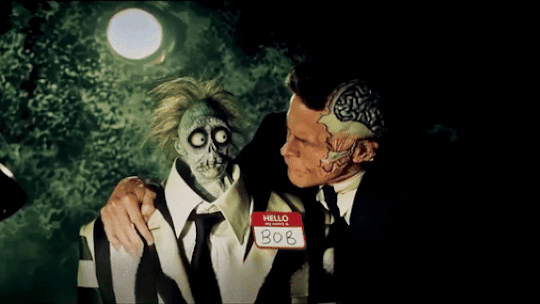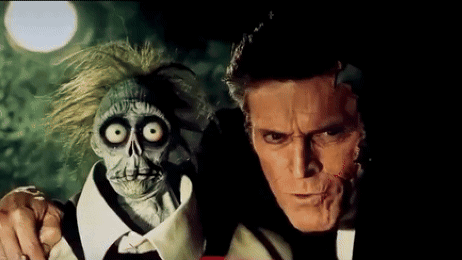#justice for bob
Explore tagged Tumblr posts
Text
Imagine confiding in Bob that you have a crush on Betelgeuse thinking he wouldn’t be able to tell him

#he probably wouldn’t anyway#justice for bob#beetlejuice beetlejuice#beetlejuice x reader#michael keaton#might write this
85 notes
·
View notes
Text

I finished my Beetlejuice AU fic that takes place during the plague. There’s a part where Beej is drafted into a feudal war and meets Bob and they become friends. Bob is the strong silent type but when he does speak his words have deep meaning. Beej often gives him advice on how to score with ladies, but Bob has a secret forbidden crush (hence why he puts up with so much shit).
There’s also a scene where Lydia writes a steamy letter for Betelgeuse that Bob offers to read out loud, but it’s a bit too hot for him.
https://archiveofourown.org/works/62163580/chapters/159013285
#beetlejuice#beetlejuice beetlejuice#ao3 fanfic#medieval au#bob#justice for Bob#beetlebabes#beetlejuice 2
33 notes
·
View notes
Text




He is so fine in this scene. 🥴
#ooh#interrogate me next#i'll cooperate#i'll tell you everything#also#justice for bob#he was done so dirty#poor guy#anyway#back to wolf#damn he looks good#so so good#i'm 🥴🥴🥴#🥵🥵🥵#wolf jackson#beetlejuice beetlejuice#willem dafoe
48 notes
·
View notes
Text
Here’s an injustice worth fighting for 💪🏼
Sign and share.
There must be some way to resurrect victims of Soul Suckers if the Soul Sucker is consumed by a Sandworm, right? There’s got to be something in the Handbook about that!

#beetlejuice#betelgeuse#tim burton#michael keaton#beetlejuice beetlejuice#justice for bob#soul sucker#sandworms#handbook for the recently deceased#bob the shrinker#beetlejuice 3#my artwork#beetlejuice fandom
20 notes
·
View notes
Text


WIPs for summer market prints! They're gonna be 4x4.
#beetlejuice#wolf jackson#justice for bob#shrunken head#ya gotta keep it real#grindarkstudio art#wip#fanart#grindark#tim burton#willem dafoe
16 notes
·
View notes
Text
Spoilers for Beetlejuice Beetlejuice:
They didn’t need to do my man Bob like that. I nearly started crying in the theater when he died. He’s just an innocent little guy
#justice for Bob#beetlejuice beetlejuice#beetlejuice#beetlejuice 2#bob beetlejuice#Beetlejuice Beetlejuice spoilers#shrinker bob#bob the shrinker
36 notes
·
View notes
Text

Made Bob at work for an event
23 notes
·
View notes
Text

Just came back from watching Beetlejuice Beetlejuice and I had to doodle Bob.
#beetlejuice beetlejuice#beetlejuice bob#justice for bob#Those shrunken heads man...that are sooo#Not me tempted to draw Bob in suggestive poses 😉😉#doodle
13 notes
·
View notes
Text

RIP Bob
3 notes
·
View notes
Text
Stranger Things did BOB friggin DIRTY
1 note
·
View note
Text

Much requested BobxBeetlejuice yaoi.
#beetlejuice#beetlejuice beetlejuice#justice for bob#bob#yaoi#bobxbeetlejuice#beetlebob#beetlejuice 2#beetlejuice fanart#keatlejuice
32 notes
·
View notes
Text

#justice for bob#beetlejuice#betelgeuse#beetlejuice beetlejuice#tim burton#bob the shrinker#afterlife call center#beetlejuice fan art
25 notes
·
View notes
Note
Your post on Bruce being the weakest human member of the league, makes me wonder what would happen if a new meta-human league member, after being criticised by Bruce for acting too rash on the field, turned around and essentially said something along the lines of 'What gives you the right to talk to me like that? At the end of the day, you're just some human.'
Cue a completely silent room and tension thick enough you could cut through it. I feel like before Bruce even had the chance to respond, multiple members of the league would step in first, especially Clark, if he's in the room when this interaction occurs.
I know it’s not super in character but I wish, in that moment, Bruce would simply step aside, tilt his head, and indicate that the meta should lead the mission themself if they feel so strongly. Kind of like when the Chef in the Menu let Tyler cook in the kitchen just to watch him fail (theoretically this would be a mission that doesn’t affect civilians etc).
Clark would be furious and so would everyone else. But maybe they’d still defer to Bruce and let the hotshot run the mission into the ground. Sometimes to teach a lesson, failure needs to be at full intensity.
Bruce would step in at the end, a la Speirs in Band of Brothers, reach a hand down to the frazzled meta, and ask him if he wanted him to step in. Calm voice, confident posture, no obvious grudge or resentment. Just Batman offering to lead the mission after all.
#actually the speirs scene in BOB where he takes over haunts me#one day I will write it into a fic#batman#bruce wayne#dc#asks#anon#clark kent#superman#justice league#jl#rambling#treadmill thoughts#except today I’m actually on an indoor track#and I almost ran into someone while typing this lmao
418 notes
·
View notes
Text
Major Thunderbolts* spoilers ahead:
Sentry!reader that joined this medical study in Malaysia and met Bob during the trials. You both hit it off immediately, and you developed a little crush on him. Little did you know, the feelings were mutual.
Sentry!reader that thought she should have died in the trials but came out alive.
Sentry!reader that was more than relieved to find out Bob also survived, but was perplexed on how they ended up in this mysterious room with a Russian spy, a mockery of Captain America, and a literal ghost.
Sentry!reader that escaped with Bob and the Thunderbolts (as Yelena chose to call them), only to be met with a militant squad trying to kill them
Sentry!reader that sacrificed her life alongside Bob in order for the Thunderbolts to escape. Only to find out they survived once again, and that they could…fly?
Sentry!reader blacking out in attempt to test these newfound powers and waking up in a dim lit room next to Bob.
Sentry!reader and Bob meeting the woman behind the trials, discovering that they were experimented on in hopes to create the perfect superhero. Except they accidentally created two “perfect superheroes”.
Sentry!reader that was arranged as Bob’s female counterpart in hopes to introduce to the world “Earth’s first super couple.”
Sentry!reader being suspicious of this arrangement, considering how forced it was, but nevertheless, agreeing upon being Bob’s fake super-girlfriend as long as they got to protect one another.
Sentry!reader and Bob being introduced to the Thunderbolts as Madame Sentry and Sentry, respectively. Then, commanded to destroy the Thunderbolts.
Sentry!reader exposing Valentina’s plan to use her and Bob as pawns in her impeachment trial.
Sentry!reader that tried to stop Bob from hurting or even killing Valentina, leading to them fighting each other, only for Mel to temporarily put them both out.
Sentry!reader that got trapped in the void with Bob, battling her own personal demons before finding Bob amongst the darkness.
Sentry!reader that learned more about Bob’s dark past and his mental illness while in the void, comforting him and reassuring him that she’ll always be on his side even in the darkness.
Sentry!reader that escaped the void with Bob, with the help of the Thunderbolts, and confessed her feelings to Bob when they revisited the lab where they met. It was only then that Bob reciprocated those feelings.
Sentry!reader confused and solemn that Bob didn’t remember the void, let alone the confessions they shared.
Sentry!reader and Bob joining forces with the Thunderbolts, which Valentina introduced to the press as The New Avengers.
Sentry!reader, after spending some time in the New Avengers tower with Bob, recalling the void with Bob. Although he didn’t remember what happened nor what was said, he knew deep down he’s always been in love with you.
Sentry!reader and Bob finally sharing a long awaited kiss, leading to their fake relationship becoming official and real.

Lowkey I can see this concept becoming more developed so if you’re interested in more of Sentry!reader/Madame Sentry, please send requests, thoughts/thots, inspo, etc here 🫶🏽
Navigation | Fic Masterlist | Robert 'Bob' Reynolds Masterlist
#this is also my first time writing in this format so I hope I did it justice :’)#request fulfilled ╰( ͡° ͜ʖ ͡° )つ──☆*:・゚#robert reynolds#bob reynolds#sentry#bob thunderbolts#lewis pullman#thunderbolts spoilers#thunderbolts*#robert reynolds x reader#sentry x reader#bob reynolds x reader#bob reynolds imagines#bob reynolds x you#sentry x you#bob reynolds fanfic#bob reynolds fluff#lewis pullman fanfic#bob x sentry!reader
141 notes
·
View notes
Text
Beetlejuice Beetlejuice spoilers
Fly high Bob. I’ll lead the revolution to get you back
#justice for bob#shrinker bob#bob beetlejuice#beetlejuice 2#beetlejuice beetlejuice#beetlejuice#bob the shrinker
29 notes
·
View notes
Text

The Wayne family of Earth-Two
#jsa#justice society of america#huntress#helena wayne#bruce wayne#batman#catwoman#selina kyle#bruce x selina#bob layton#rich seetoo
117 notes
·
View notes